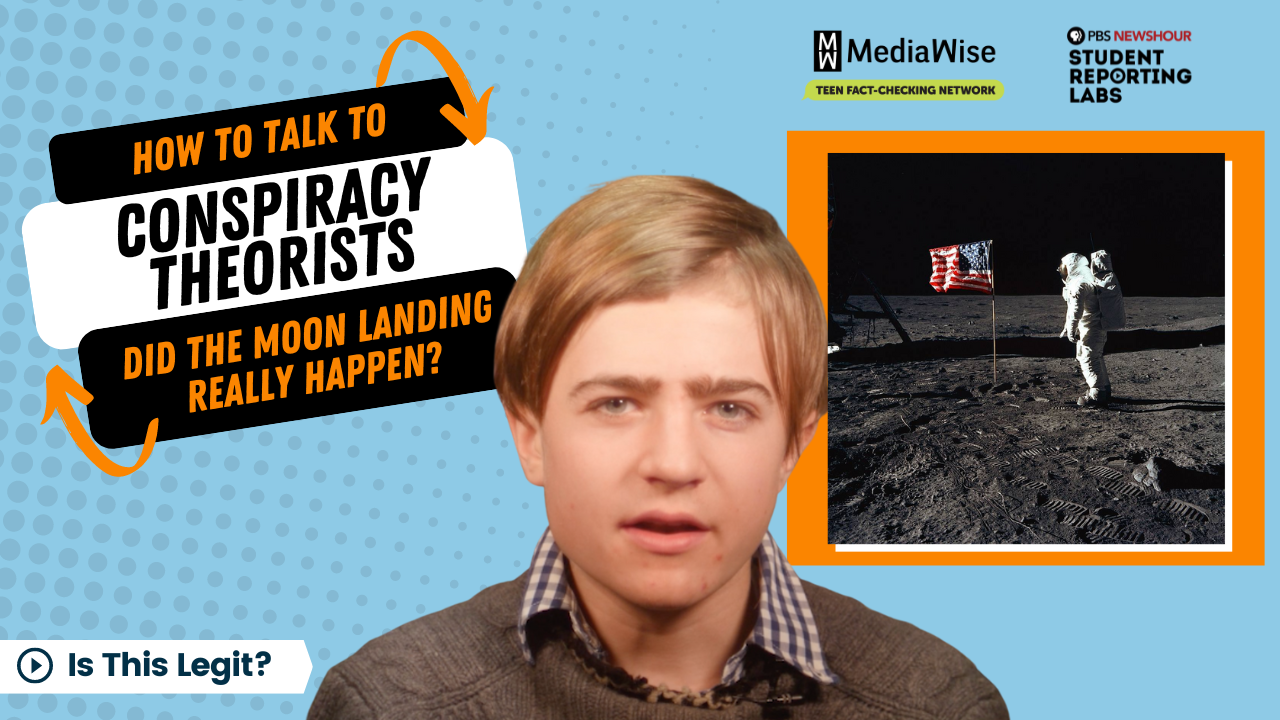The season is upon us, which means you’ll likely be gathering with family members and friends to share a holiday meal, but that can also mean sharing some dubious claim someone has seen on the internet.
So we’d like to offer you a couple of tactics to use over the holidays to counter those claims you might face from your wacky relatives or friends — and to keep the peace.
Moon landing
Let’s start with a conspiracy theory that is very common. Ever since NASA sent men to the moon in 1969, people have spread the story that the moon landing was a hoax
Despite mountains of evidence to the contrary, somewhere between 6-20% of Americans still believe the landing was faked, according to this Vox article from 2019.
Let’s look into that particular claim and along the way learn about some tactics for discussing these types of conspiracy theories with people who believe them.
What is a conspiracy theory?
According to an article in Scientific American, conspiracy theories are “the idea that people or groups are colluding in hidden ways to produce a particular outcome.” The article says people latch on to them because they have a need to understand major news events.
Now, the moon landing in 1969 was one of the biggest news events of the era. About 600-million people watched it on TV as it happened — but almost from the beginning people denied that it occurred.
When big news events occur, such as a mass shooting or a pandemic — or a moon landing — people may be drawn into conspiracy theories because they want to understand why and how events happen. They have a need to make “the world seem more straightforward and controllable,” the Scientific American article says.
People also sometimes fall into conspiracy theories because they have a need to seek out community in numbers, and being part of a conspiracy theory involves a developed community.
During the pandemic people were stuck at home, with lots of time to look for social connections online and sometimes finding themselves falling into rabbit holes.
That waving moon flag
Often, moon landing conspiracy theorists cite this video of astronaut Buzz Aldrin putting the American flag into the soil on the moon. In the video the flag appears to blow as it would in the wind on earth. However, there is no wind on the moon, so many conspiracy theorists believe this proves that the landing was faked.
A Google keyword search of “why does the American flag look like it’s blowing in the wind on the moon?” quickly gives me the answer. I found this Washington Post story, which says that engineers inserted a horizontal rod in the top hem to make the flag stand out for the photo. And the flag looks like it’s rippling because the astronauts had trouble pulling the rod all the way out.
Look closely: You can see the rod!
How to talk to family and friends
An article from the BBC offers these tips when confronted with a person who believes a conspiracy theory:
- Keep calm. Don’t ever get into a shouting match with them. Instead, it’s a good idea to really listen to what they are saying.
- Don’t be judgmental or dismissive. Attacking someone over their beliefs can push them further into a disinformation rabbit hole.
Also, try adding a little logic. While doing my research, I found this article from LiveScience, a science-focused news website. The article explains a study that looked at NASA employment numbers from 1965, when planning for the moon landing was in full swing. During that time there were 411,000 NASA employees, at least 650 of whom were directly involved with the moon landing. This meant that – assuming the moon landing was faked – all 650 employees and likely more would have had to keep it a secret, which just doesn’t seem plausible.
Ask open-ended questions
Encourage people who believe in conspiracy theories to use critical thinking and to consider other points of view. Many people who believe the moon landing was a hoax think that the landing was filmed by Stanley Kubrick, director of the film, 2001 A Space Odyssey.
Yes, with today’s graphics technology it would be possible to recreate the lighting and other effects on the moon. But in 1969, this wouldn’t have been possible since computer graphics hadn’t come nearly as far. Simply put, it would’ve been easier to put a man on the moon than to fake the landing altogether.
Rating
NOT LEGIT. There is no evidence to show the conspiracy theory is true – and an overload of evidence to the contrary.
We chose the moon landing conspiracy theory to focus on here because it serves as an interesting example of how these theories often include flawed and straight-up false logic, but there are a multitude of dubious claims out there, and we hope these tips are useful for any of them.
With that settled, in this holiday season, it’s important to remember that political issues and conspiracy theories like this one can often create conflict among family members.
Whatever you do, don’t write off your relatives or friends. Be there for them when they are ready to accept the truth.
ATTENTION TEACHERS: This fact-check is featured in a free, one-hour lesson plan about what a conspiracy theory is and how to talk to relatives and friends who are drawn into them. The lesson is available through PBS LearningMedia, and includes lesson summary and a handout, among other resources.






